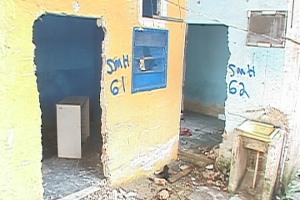Part 3 in a 6-part series on the forced removal of Vila Autodromo
 |
| The Azure Letter. Houses marked for removal in Autodromo. Photo credit: RioOnWatch |
I had the privilege of visiting Vila Autodromo last week to meet with community leader Jane Nascimento, who has been instrumental in the community’s fight against an otherwise sealed fate. Although the community was scheduled to be removed in March, the SMH has been unable to bulldoze a single house, thanks in part to Nascimento’s vociferous opposition. “They [the SMH ] have tried to come here a few times with their bulldozers,” she tells me. “But we have resisted. We blockade the roads, and they cannot enter.”
That same day, Jane leads me and a group of other independent researchers on a walking tour of Vila Autodromo. It is not difficult to see why the government is interested in this swatch of prime real estate, marking its territory with the now-infamous blue grafitti the SMH uses to deface the facades of houses it will soon remove. Peppered with lush vegetation, Autodromo is flanked by a main boulevard on one side and the lagoon on the other, and boasts top-notch views of the massive body of water. In order to legally remove the community, however, the government must navigate through a series of articles in the City Statue designed to protect land tenure for all but the most precarious settlements. One legal instrument is Article 429, the Lei Organica do Municipio, which stipulates that removal is only justified when an informal settlement occupies a tract of land that “poses a signficant risk to its residents.” This wording leaves some room for ambiguity in its definition of “significant risk”, and indeed it is this exact piece of legislation that is being manipulated by the municipal government in order to authorize the forced evictions. The SMH has recently cited “pollution” and “flood risk” as reasons for Vila Autodromo’s removal despite the fact that residents are hard-pressed to remember the last time the community had a flood, and that most of the water-borne pollution comes from other residential areas surrounding the lagoon, as Seu Francisco described.
Jane goes on to express her fear that, despite the community’s past success in thwarting demolition (the community was scheduled to be removed in March of this year), the SMH may soon begin bulldozing houses, businesses, and the newly erected community church. Particularly, she worries that residents will be relocated to the militia-controlled Minha Casa Minha Vida apartments, which offer little in the way of amenities – much less a community-built place of open worship. Jane explains, “If we are relocated, we want everything that we have here, there [in the Minha Casa Minha Vida complex].”

No comments:
Post a Comment